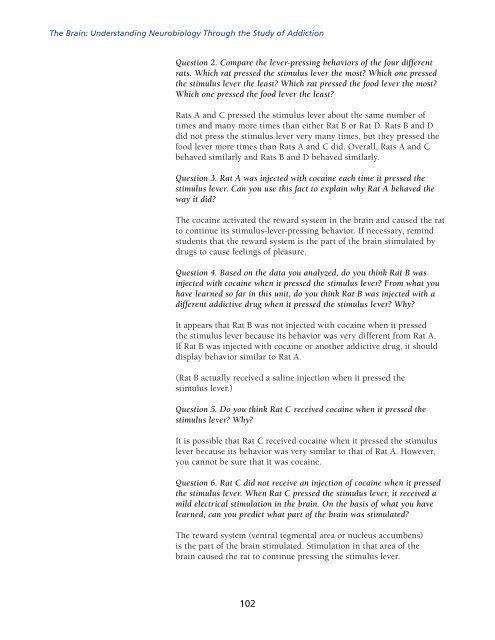Drug Abuse And Addiction - NIH Office of Science Education
Drug Abuse And Addiction - NIH Office of Science Education
Drug Abuse And Addiction - NIH Office of Science Education
You also want an ePaper? Increase the reach of your titles
YUMPU automatically turns print PDFs into web optimized ePapers that Google loves.
The Brain: Understanding Neurobiology Through the Study <strong>of</strong> <strong>Addiction</strong>Question 2. Compare the lever-pressing behaviors <strong>of</strong> the four differentrats. Which rat pressed the stimulus lever the most? Which one pressedthe stimulus lever the least? Which rat pressed the food lever the most?Which one pressed the food lever the least?Rats A and C pressed the stimulus lever about the same number <strong>of</strong>times and many more times than either Rat B or Rat D. Rats B and Ddid not press the stimulus lever very many times, but they pressed thefood lever more times than Rats A and C did. Overall, Rats A and Cbehaved similarly and Rats B and D behaved similarly.Question 3. Rat A was injected with cocaine each time it pressed thestimu lus lever. Can you use this fact to explain why Rat A behaved theway it did?The cocaine activated the reward system in the brain and caused the ratto continue its stimulus-lever-pressing behavior. If necessary, remindstudents that the reward system is the part <strong>of</strong> the brain stimulated bydrugs to cause feelings <strong>of</strong> pleasure.Question 4. Based on the data you analyzed, do you think Rat B wasinjected with cocaine when it pressed the stimulus lever? From what youhave learned so far in this unit, do you think Rat B was injected with adifferent addictive drug when it pressed the stimulus lever? Why?It appears that Rat B was not injected with cocaine when it pressedthe stimulus lever because its behavior was very different from Rat A.If Rat B was injected with cocaine or another addictive drug, it shoulddisplay behavior similar to Rat A.(Rat B actually received a saline injection when it pressed thestimulus lever.)Question 5. Do you think Rat C received cocaine when it pressed thestim ulus lever? Why?It is possible that Rat C received cocaine when it pressed the stimuluslever because its behavior was very similar to that <strong>of</strong> Rat A. However,you can not be sure that it was cocaine.Question 6. Rat C did not receive an injection <strong>of</strong> cocaine when it pressedthe stimulus lever. When Rat C pressed the stimulus lever, it received amild electrical stimulation in the brain. On the basis <strong>of</strong> what you havelearned, can you predict what part <strong>of</strong> the brain was stimulated?The reward system (ventral tegmental area or nucleus accumbens)is the part <strong>of</strong> the brain stimulated. Stimulation in that area <strong>of</strong> thebrain caused the rat to continue pressing the stimulus lever.102
















